A Systematic Review of Dynamic Forces and Kinematic Indicators of Front and Roundhouse Kicks across Varied Conditions and Participant Experience
Abstract
1. Introduction
2. Materials and Methods
2.1. Literature Search
2.2. Eligibility Criteria
2.3. Study Selection
2.4. Data Collection Process
2.5. Assessment of Methodological Quality and Risk of Bias
2.6. Data Treatment
2.7. Statistical Analysis
3. Results
3.1. Forest Plots of Front and Roundhouse Kicks
3.2. Comparing the Kicks’ Dynamic Forces and Kinematic Indicators
3.3. Impact Force of the Kick
3.4. The Velocity of the Knee and Hip
3.5. The Velocity of the Foot
3.6. Angular Velocity of the Knee and Hip
3.7. Execution Time
4. Discussion
4.1. The Impact Force of the Kicks
4.2. The Maximum Velocity of Kicks
4.3. Angular Velocity of Kicks
4.4. Execution Time of Kicks
4.5. Limitations of the Study
5. Conclusions
Supplementary Materials
Author Contributions
Funding
Institutional Review Board Statement
Informed Consent Statement
Data Availability Statement
Conflicts of Interest
References
- Dworak, L.B.; Dziewiecki, K.; Maczynski, J. Characteristics of Kinematics and Kinetics of Strokes in Karate-Biomechanical Approach. In 23th International Symposium on Biomechanics in Sport, Beijing, China. 2005. Available online: https://ojs.ub.uni-konstanz.de/cpa/article/view/848 (accessed on 23 July 2023).
- Vagner, M.; Cleather, D.; Kubovy, P.; Hojka, V.; Stastny, P. Effect of Strength Training Programs on Front Push Kick Dynamics and Kinematics. Arch. Budo 2021, 17, 237–251. [Google Scholar]
- Cynarski, W.; Wąsik, J.; Szymczyk, D.; Vences de Brito, A. Changes in Foot Pressure on the Ground during Mae-Geri Kekomi (Front Kick) in Karate Athlete—Case Study. Phys. Educ. Stud. 2018, 22, 12–16. [Google Scholar] [CrossRef]
- Gordon, D.; Robertson, E. How Biomechanics Can Improve Sports Performance. In First Annual Conference of the International Seminar on Biomechanics. Instituto Universitario de Educación Física; Universidad de Antioquia: Medellín, Colombia, 2011; Volume 39, pp. 17–38. [Google Scholar]
- Błaszczyszyn, M.; Szczęsna, A.; Pawlyta, M.; Marszałek, M.; Karczmit, D. Kinematic Analysis of Mae-Geri Kicks in Beginner and Advanced Kyokushin Karate Athletes. Int. J. Environ. Res. Public Health 2019, 16, 3155. [Google Scholar] [CrossRef] [PubMed]
- Ervilha, U.F.; Fernandes, F.D.M.; de Souza, C.C.; Hamill, J. Reaction Time and Muscle Activation Patterns in Elite and Novice Athletes Performing a Taekwondo Kick. Sport Biomech. 2018, 19, 665–677. [Google Scholar] [CrossRef]
- Pozo, J.; Bastien, G.; Dierick, F. Execution Time, Kinetics, and Kinematics of the Mae-Geri Kick: Comparison of National and International Standard Karate Athletes. J. Sports Sci. 2011, 29, 1553–1561. [Google Scholar] [CrossRef] [PubMed]
- Ramakrishnan, K.R.; Wang, H.; Shankar, K.; Fien, A. A New Method for the Measurement and Analysis of Biomechanical Energy Delivered by Kicking. Sport. Eng. 2018, 21, 53–62. [Google Scholar] [CrossRef]
- Szczęsna, A.; Błaszczyszyn, M.; Pawlyta, M. Optical Motion Capture Dataset of Selected Techniques in Beginner and Advanced Kyokushin Karate Athletes. Sci. Data 2021, 8, 13. [Google Scholar] [CrossRef]
- Vagner, M.; Cleather, D.J.; Kubový, P.; Hojka, V.; Stastny, P. Principal Component Analysis Can Be Used to Discriminate Between Elite and Sub-Elite Kicking Performance. Mot. Control. 2022, 27, 354–372. [Google Scholar] [CrossRef]
- VencesBrito, A.M.; Branco, M.A.C.; Fernandes, R.M.C.; Ferreira, M.A.R.; Fernandes, O.J.S.M.; Figueiredo, A.A.A.; Branco, G. Characterization of Kinesiological Patterns of the Frontal Kick, Maegeri, in Karate Experts and Nonkarate Practitioners. Rev. Artes Marciales Asiáticas 2014, 8, 451–465. [Google Scholar]
- Estevan, I.; Falco, C. Mechanical Analysis of the Roundhouse Kick According to Height and Distance in Taekwondo. Biol. Sport 2013, 30, 275–279. [Google Scholar] [CrossRef]
- Estevan, I.; Álvarez, O.; Falco, C.; Molina-García, J.; Castillo, I. Impact Force and Time Analysis Influenced by Execution Distance in a Roundhouse Kick to the Head in Taekwondo. J. Strength Cond. Res. 2011, 25, 2851–2856. [Google Scholar] [CrossRef] [PubMed]
- Falco, C.; Alvarez, O.; Castillo, I.; Estevan, I.; Martos, J.; Mugarra, F.; Iradi, A. Influence of the Distance in a Roundhouse Kick’s Execution Time and Impact Force in Taekwondo. J. Biomech. 2009, 42, 242–248. [Google Scholar] [CrossRef] [PubMed]
- Vagner, M.; Thiel, D.; Jelen, K.; Tomšovský, L.; Kubový, P.; Tufano, J.J. Wearing Ballistic and Weighted Vests Increases Front Kick Forces. Arch. Budo 2018, 14, 231–237. [Google Scholar]
- Vagner, M.; Maleček, J.; Hojka, V.; Kubový, P.; Stastny, P. A Carried Military Load Increases the Impact Force and Time of a Front Kick but Reduces the Peak Velocity of the Hip and Shoulder of the Kicking Leg. Arch. Budo 2020, 16, 69–76. [Google Scholar]
- Vagner, M.; Cleather, D.; Kubovy, P.; Hojka, V.; Stastny, P. Kinematic Determinants of Front Kick Dynamics Across Different Loading Conditions. Mil. Med. 2022, 187, 147–153. [Google Scholar] [CrossRef]
- Kim, Y.K.; Kim, Y.H.; Im, S.J. Inter-Joint Coordination in Producing Kicking Velocity of Taekwondo Kicks. J. Sport. Sci. Med. 2011, 10, 31–38. [Google Scholar]
- Wąsik, J.; Mosler, D.; Ortenburger, D.; Góra, T.; Cholewa, J. Kinematic Effects of the Target on the Velocity of Taekwon-Do Roundhouse Kicks. J. Hum. Kinet. 2021, 80, 61–69. [Google Scholar] [CrossRef]
- Buśko, K.; Nikolaidis, P.T. Biomechanical Characteristics of Taekwondo Athletes: Kicks and Punches vs. Laboratory Tests. Biomed. Hum. Kinet. 2018, 10, 81–88. [Google Scholar] [CrossRef]
- Diniz, R.; Del Vecchio, F.B.; Schaun, G.Z.; Oliveira, H.B.; Portella, E.G.; da Silva, E.S.; Formalioni, A.; Campelo, P.C.C.; Peyré-Tartaruga, L.A.; Pinto, S.S. Kinematic Comparison of the Roundhouse Kick between Taekwondo, Karate, and Muaythai. J. Strength Cond. Res. 2018, 35, 198–204. [Google Scholar] [CrossRef]
- Górski, M.; Orysiak, J. Differences between Anthropometric Indicators and the Impact Force of Taekwondo Kicks Performed with the Dominant and Non-Dominant Limb. Biomed. Hum. Kinet. 2019, 11, 193–197. [Google Scholar] [CrossRef]
- Falco, C.; Molina-García, J.; Álvarez, O.; Estevan, I. Effects of Target Distance on Select Biomechanical Parameters in Taekwondo Roundhouse Kick. Sport. Biomech. 2013, 12, 381–388. [Google Scholar] [CrossRef]
- Vagner, M.; Tomšovský, L.; Tufano, J.J.; Kubový, P.; Jelen, K. The Effect of Military Boots on Front Kick Dynamics. AUC Kinanthropologica 2018, 54, 129–136. [Google Scholar] [CrossRef]
- Kim, J.W.; Kwon, M.S.; Yenuga, S.S.; Kwon, Y.H. The Effects of Target Distance on Pivot Hip, Trunk, Pelvis, and Kicking Leg Kinematics in Taekwondo Roundhouse Kicks. Sport. Biomech. 2010, 9, 98–114. [Google Scholar] [CrossRef]
- Gianino, C. Physics of Karate. Kinematics Analysis of Karate Techniques by a Digital Movie Camera. Lat. Am. J. Phys. Educ. 2010, 4, 32–34. [Google Scholar]
- Milošević, M.; Mudrić, R.; Mudrić, M. The Biomechanical Analysis of the Karate Kick (Mae Geri) in the Function of Defining Educational Training Aims and Methods. Sport Sci. Pract. 2012, 2, 5–14. [Google Scholar]
- Tang, W.T.; Chang, J.S.; Nien, Y.H. The Kinematics Characteristics of Preferred and Non-Preferred Roundhouse Kick in Elite Taekwondo Athletes. J. Biomech. 2007, 40, S780. [Google Scholar] [CrossRef]
- Wilk, S.R.; Mcnair, R.E.; Feld, M.S. The Physics of Karate. Cit. Am. J. Phys. 1983, 51, 783. [Google Scholar] [CrossRef]
- Sbriccoli, P.; Camomilla, V.; Di Mario, A.; Quinzi, F.; Figura, F.; Felici, F. Neuromuscular Control Adaptations in Elite Athletes: The Case of Top Level Karateka. Eur. J. Appl. Physiol. 2010, 108, 1269–1280. [Google Scholar] [CrossRef] [PubMed]
- Sørensen, H.; Zacho, M.; Simonsen, E.B.; Dyhre-Poulsen, P.; Klausen, K. Dynamics of the Martial Arts High Front Kick. J. Sports Sci. 1996, 14, 483–495. [Google Scholar] [CrossRef]
- Wąsik, J.; Czarny, W.; Małolepszy, E.; Drozdek-Małolepsza, T. Kinematics of Taekwon-Do Front Kick. Arch. Budo Sci. Martial Arts Extrem. Sport 2015, 11, 23–28. [Google Scholar]
- Kellis, E.; Katis, A. Quantification of Functional Knee Flexor to Extensor Moment Ratio Using Isokinetics and Electromyography. J. Athl. Train. 2007, 42, 477–485. [Google Scholar] [CrossRef] [PubMed]
- Estevan, I.; Falco, C.; Álvarez, O.; Molina-García, J. Effect of Olympic Weight Category on Performance in the Roundhouse Kick to the Head in Taekwondo. J. Hum. Kinet. 2012, 31, 37–43. [Google Scholar] [CrossRef] [PubMed]
- Estevan, I.; Jandacka, D.; Falco, C. Effect of Stance Position on Kick Performance in Taekwondo. J. Sports Sci. 2013, 31, 1815–1822. [Google Scholar] [CrossRef] [PubMed]
- Moher, D.; Liberati, A.; Tetzlaff, J.; Altman, D.G.; Group, T.P. Preferred Reporting Items for Systematic Reviews and Meta-Analyses: The PRISMA Statement. PLoS Med. 2009, 6, e1000097. [Google Scholar] [CrossRef] [PubMed]
- Moher, D.; Stewart, L.; Shekelle, P. Implementing PRISMA-P: Recommendations for Prospective Authors. Syst. Rev. 2016, 5, 15. [Google Scholar] [CrossRef]
- Vandenbroucke, J.P.; Von Elm, E.; Altman, D.G.; Gøtzsche, P.C.; Mulrow, C.D.; Pocock, S.J.; Poole, C.; Schlesselman, J.J.; Egger, M. Strengthening the Reporting of Observational Studies in Epidemiology (STROBE): Explanation and Elaboration. Epidemiology 2007, 1, 805–835. [Google Scholar] [CrossRef]
- Goethel, M.F.; Ervilha, F.U.; Moreira, S.P.V.; Silva, V. de P.; Bendillati, A.R.; Cardozo, C.A.; Gonçalves, M. Coordinative Intra-Segment Indicators of Karate Performance. Arch Budo 2019, 15, 203–211. [Google Scholar]
- Portela, B.S.; Barbosa, M.R.; Cavazzotto, T.G.; Tartaruga, M.P. Kinematics Analysis of the Front Kick with and without Impact on Traditional Karate. Arch. Budo 2014, 10, 47–51. [Google Scholar]
- Wąsik, J.; Góra, T. Impact of Target Selection on Front Kick Kinematics in Taekwondo—Pilot Study. Phys. Act. Rev. 2016, 4, 57–61. [Google Scholar] [CrossRef]
- Wąsik, J.; Ortenburger, D.; Góra, T.; Shan, G.; Mosler, D.; Wodarski, P.; Michnik, R.A. The Influence of Gender, Dominant Lower Limb and Type of Target on the Velocity of Taekwon-Do Front Kick. Acta Bioeng. Biomech. 2018, 20, 133–138. [Google Scholar] [CrossRef]
- Olsen, P.D.; Hopkins, W.G. The Effect of Attempted Ballistic Training on the Force and Speed of Movements. J. Strength Cond. Res. 2003, 17, 291–298. [Google Scholar] [PubMed]
- Abraham, C.; Kingman, J.; Dyson, R. Maximum Velocity of the Striking Leg during the Martial Arts Front, Side and Turning Kicks and the Relationship to Technique Duration. In 19 International Symposium on Biomechanics in Sports; University of San Francisco: San Francisco, CA, USA, 2001; pp. 158–161. [Google Scholar]
- Wasik, J.; Ortenburger, D.; Gora, T. Studies of Kicking of Three Targets—Does Sex Differentiate the Velocity of the Taekwondo Front Kick? Balt. J. Health Phys. Act. 2019, 11, 76–82. [Google Scholar] [CrossRef]
- Branco, M.A.C.; Vencesbrito, A.M.V.; Rodrigues-Ferreira, M.A.; Branco, G.A.C.; Polak, E.; Cynarski, W.J.; Jacek, W. Effect of Aging on the Lower Limb Kinematics in Karate Practitioners: Comparing Athletes and Their Senseis. J. Healthc. Eng. 2019, 2019, 2672185. [Google Scholar] [CrossRef] [PubMed]
- Thibordee, S.; Prasartwuth, O. Effectiveness of Roundhouse Kick in Elite Taekwondo Athletes. J. Electromyogr. Kinesiol. 2014, 24, 353–358. [Google Scholar] [CrossRef]
- Estevan, I.; Álvarez, O.; Falco, C.; Castilloo, I. Self-Efficacy and Performance of the Roundhouse Kick in Taekwondo. Rev. Artes Marciales Asiáticas 2014, 9, 97–105. [Google Scholar] [CrossRef]
- Gavagan, C.J.; Sayers, M.G.L.A. Biomechanical Analysis of the Roundhouse Kicking Technique of Expert Practitioners: A Comparison between the Martial Arts Disciplines of Muay Thai, Karate, and Taekwondo. PLoS ONE 2017, 12, e0182645. [Google Scholar] [CrossRef]
- Detjareny, T.; Limroongreungrat, W.; Sinphurmsukskul, O.; Pinthong, M. Kinematic Differences of Taekwondo Roundhouse Kicks between Thailand National Athletes and Youth National Athletes. In Proceedings of 30th International Symposium on Biomechanics in Sports; Bradshaw, E.J., Bernett, A., Hume, P.A., Eds.; International Society of Biomechanics in Sports: Melbourne, Australia, 2012; pp. 185–188. [Google Scholar]
- Moreira, P.V.; Falco, C.; Menegaldo, L.L.; Fagundes Goethel, M.; Vinhas De Paula, L.; Gonçalves, M. Are Isokinetic Leg Torques and Kick Velocity Reliable Predictors for Competitive Success in Taekwondo Athletes? PLoS ONE 2021, 16, e0235582. [Google Scholar] [CrossRef]
- Nien, Y.H.; Chang, J.S.; Tang, W.T. The Comparison Of Kinematics Characteristics Of Two Roundhouse Kicking Techniques In Elite Taekwondo Athletes. Med. Sci. Sport Exerc. 2007, 39, S478. [Google Scholar] [CrossRef]
- Quinzi, F.; Camomilla, V.; Felici, F.; Di Mario, A.; Sbriccoli, P. Differences in Neuromuscular Control between Impact and No Impact Roundhouse Kick in Athletes of Different Skill Levels. J. Electromyogr. Kinesiol. 2013, 23, 140–150. [Google Scholar] [CrossRef]
- Liu, T.T.; Lin, Y.C.; Tang, W.T.; Hamill, J.; Chang, J.S. Lower-Limb Kinematic Characteristics of Taekwondo Kicks at Different Attack Angles. Int. J. Perform. Anal. Sport 2021, 21, 519–531. [Google Scholar] [CrossRef]
- Petre, R.L.; Teodoru, M.D. Measurement of the Strike Execution Speed in Karate-Do by Using the Quntic Information System. In The 9th International Scientific Conference eLearning and software for Education; Carol I National Defence University Publishing House: Bucharest, Romania, 2013; pp. 179–185. [Google Scholar] [CrossRef]
- Chinnasee, C.; Mohamad, N.I.; Nadzalan, A.M.; Sazili, A.H.A.; Hemapandha, W.; Khan, T.K.A.; Tan, K.; Science, S.; Pendidikan, U.; Idris, S.; et al. Lower Limb Kinematics Analysis during Rounhouse Kick among Novices in Muay Thai. J. Fundam. Appl. Sci. 2017, 9, 1002–1010. [Google Scholar] [CrossRef][Green Version]
- Jung, T.; Park, H. The Effects of Back-Step Footwork on Taekwondo Roundhouse Kick for the Counterattack. Eur. J. Hum. Mov. 2020, 44, 129–145. [Google Scholar] [CrossRef]
- Jung, T.; Park, H. The Effects of Defensive Footwork on the Kinematics of Taekwondo Roundhouse Kicks. Eur. J. Hum. Mov. 2018, 40, 78–95. [Google Scholar]
- Quinzi, F.; Camomilla, V.; Felici, F.; Sbriccoli, P. Repeated Kicking Actions in Karate: Effect on Technical Execution in Elite Practitioners. Int. J. Sports Physiol. Perform. 2016, 11, 363–369. [Google Scholar] [CrossRef] [PubMed]
- Vagner, M.; Malecek, J.; Tomšovsky, L.; Kubovy, P.; Levitova, A.; Stastny, P. Isokinetic Strength of Rotators, Flexors and Hip Extensors Is Strongly Related to Front Kick Dynamics in Military Professionals. J. Hum. Kinet. 2019, 68, 145–155. [Google Scholar] [CrossRef] [PubMed]
- Vagner, M.; Olah, V.; Cleather, D.J.; Stastny, P. Evidence-Based Functional Training to Improve Front Push Kick Technique, Speed, and Net Force Production. Strength Cond. J. 2022, 44, 58–68. [Google Scholar] [CrossRef]
- Pieter, F.; Pieter, W. Speed and force in selected taekwondo techniques. Biol. Sport 1995, 12, 257–266. [Google Scholar]
- Grymanowski, J.; Glinska-Wlaz, J.; Ruzbarsky, P.; Druzbicki, M.; Przednowek, K. Analysis of Time-Space Parameters of the Front Kick Using the Example of an Athlete Training in Muay Thai. Ido Mov. Cult. 2019, 19, 107–110. [Google Scholar] [CrossRef]
- Moreira, P.V.; Franchini, E.; Ervilha, U.; Goethel, M.F.; Cardozo, A.C.; Gonçalves, M. Relationships of the expertise level of taekwondo athletes with electromyographic, kinematic and ground reaction force performance indicators during the dollyo chagui kick. Arch. Budo 2018, 14, 59–69. [Google Scholar]
- Quinzi, F.; Sbriccoli, P.; Alderson, J.; Di Mario, A.; Camomilla, V. Intra-limb coordination in karate kicking: Effect of impacting or not impacting a target. Hum. Mov. Sci. 2014, 33, 108–119. [Google Scholar] [CrossRef]
- Jeon, Y.; Kim, Y.; Ji, Y. Specific Muscle Coordination Patterns of Taekwondo Roundhouse Kick in Athletes and Non-Athletes. Arch. Budo 2021, 17, 135–144. [Google Scholar]
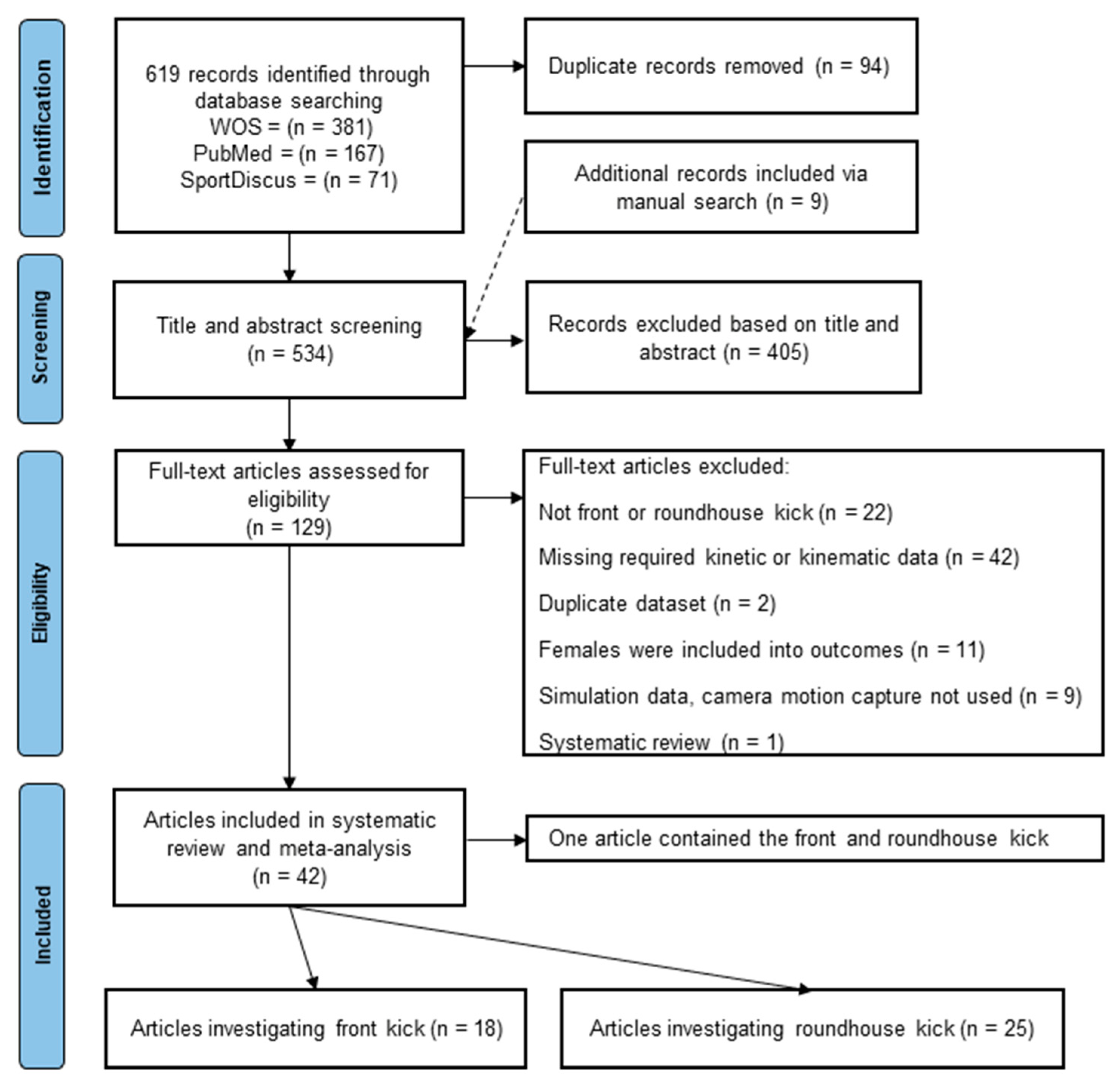
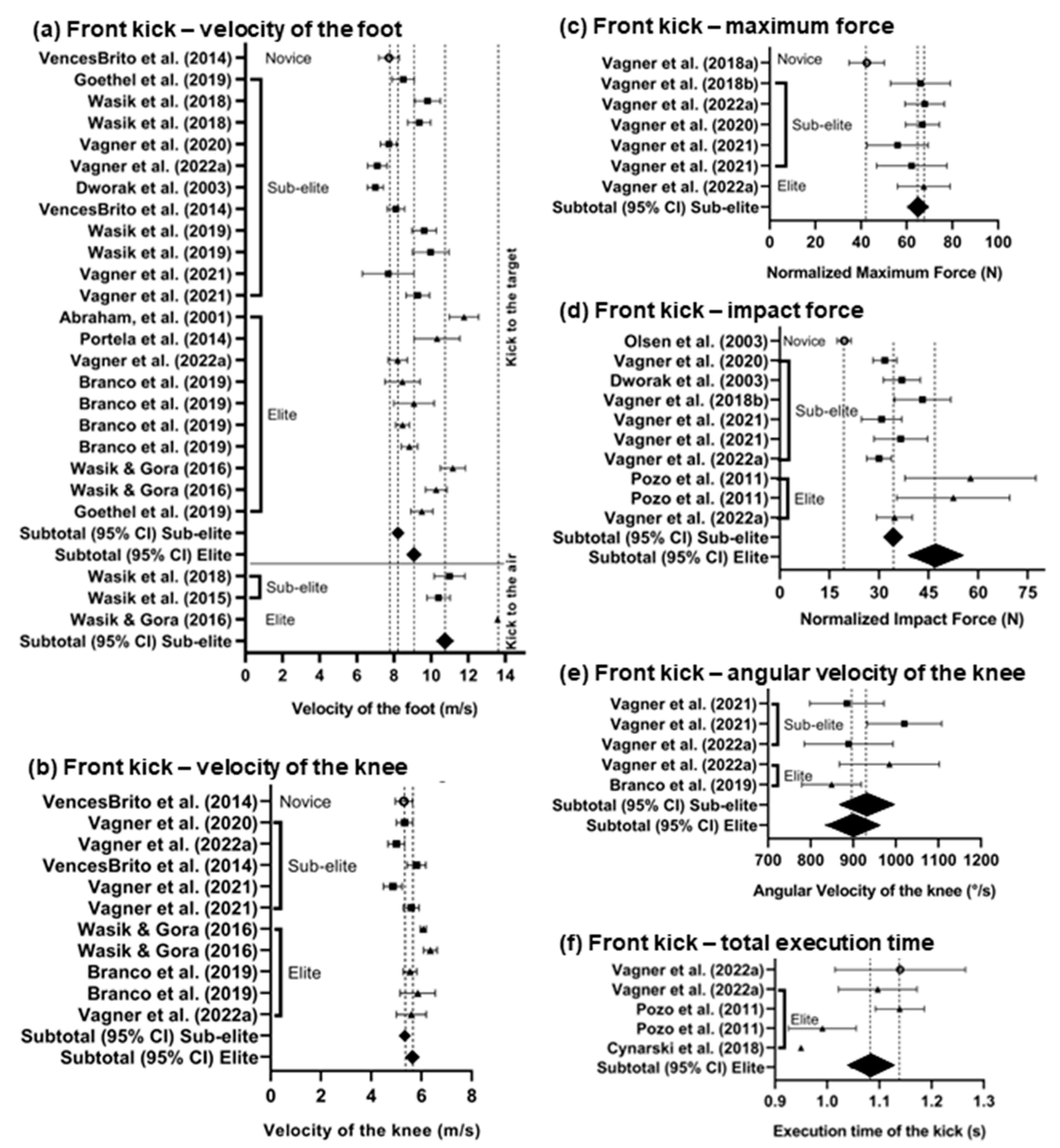
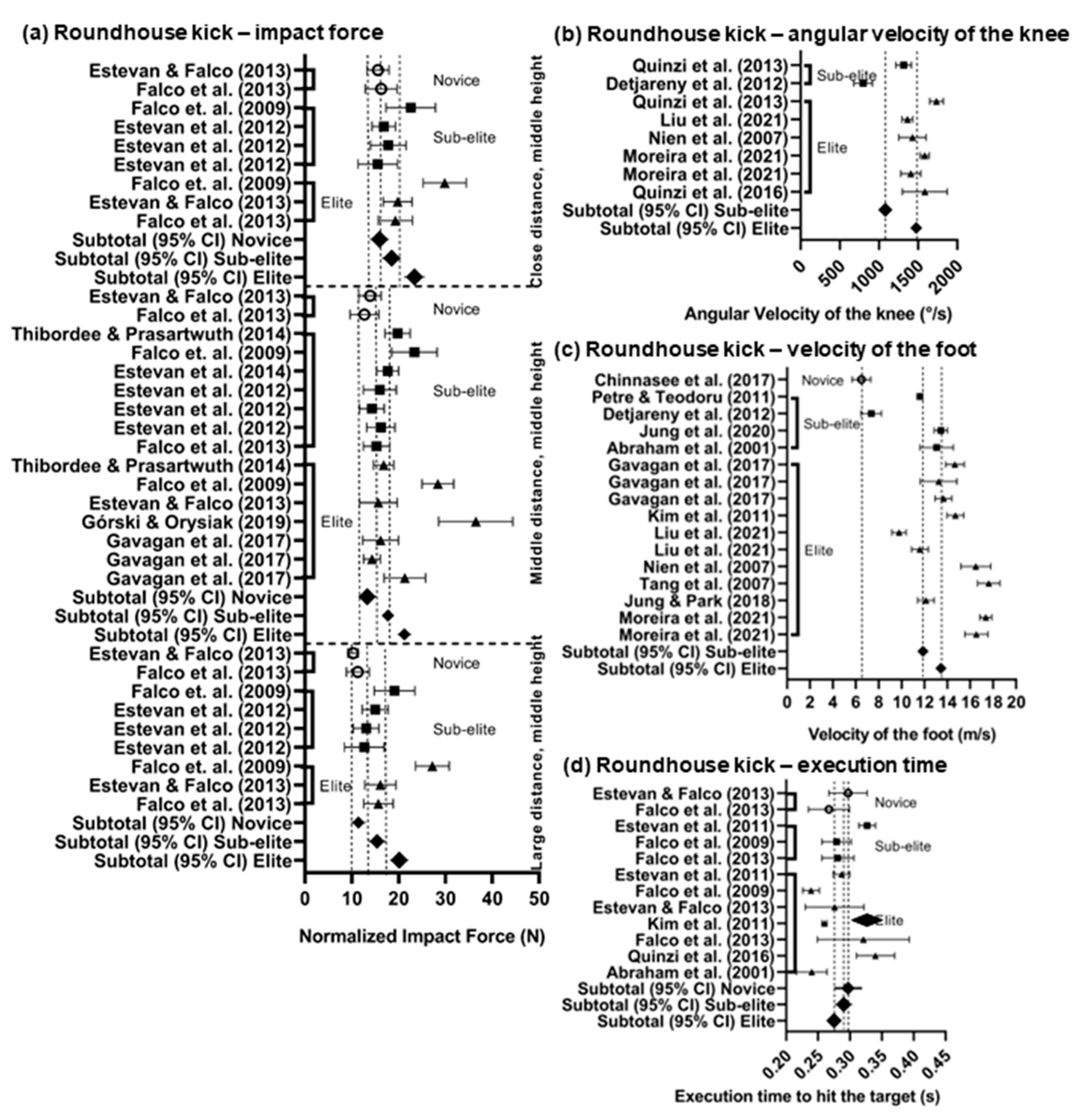
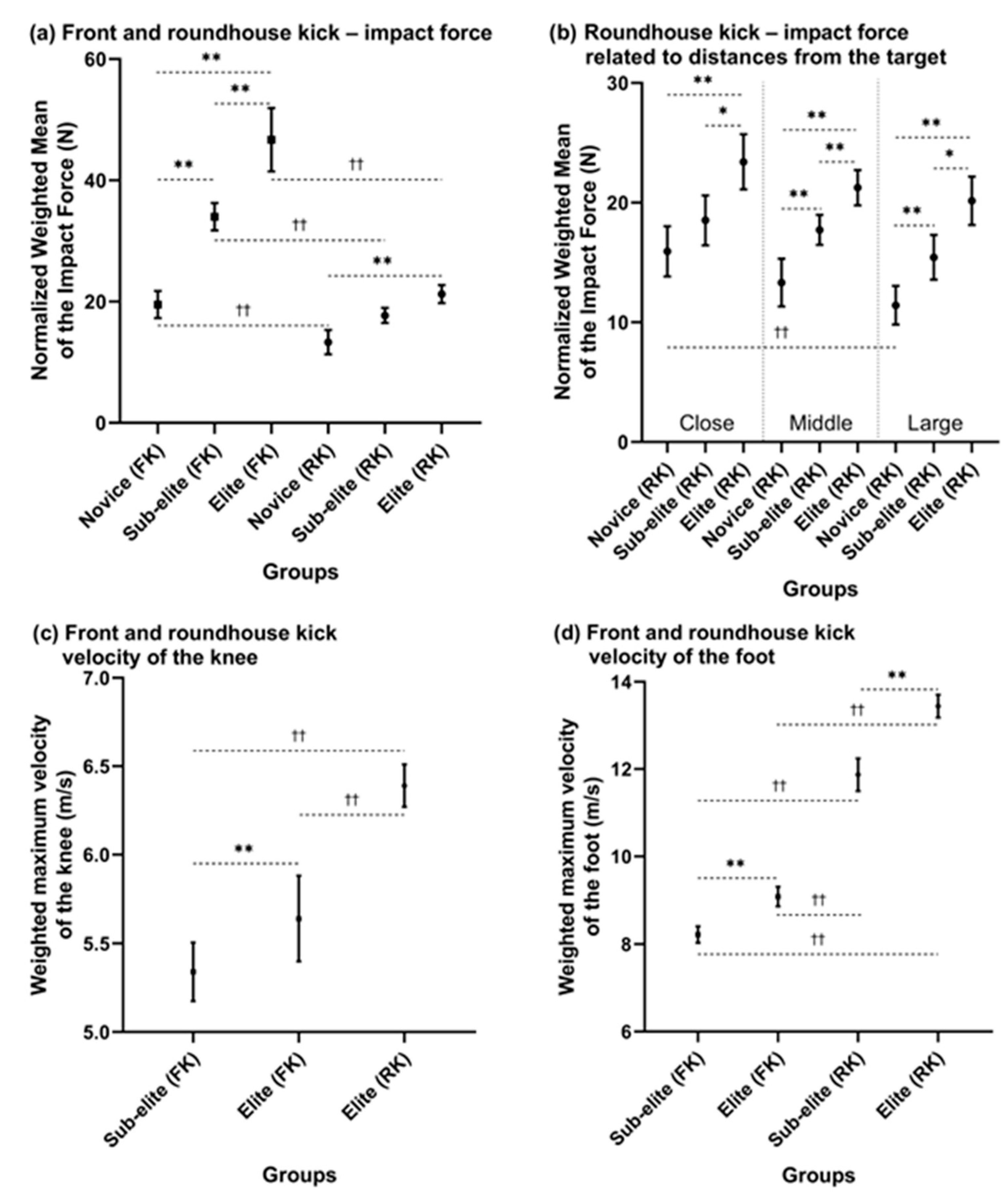
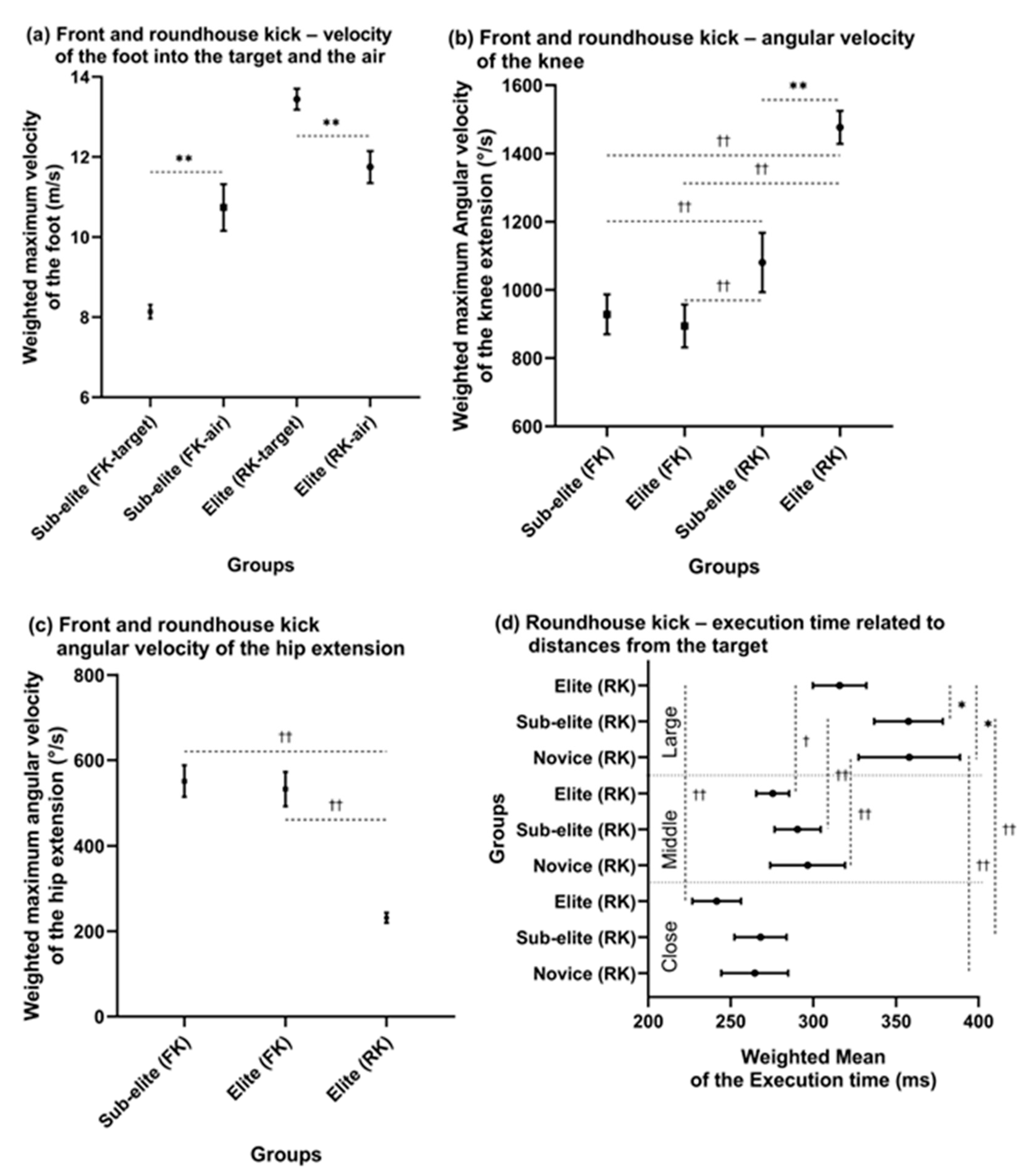
| Front Kick | Novice | Sub-Elite | Elite | Novice | Sub-Elite | Elite |
|---|---|---|---|---|---|---|
| Maximum Force (N) | Impact Force (N) | |||||
| Number of mean results | 1 | 5 | 1 | 1 | 6 | 3 |
| Number of participants | 6 | 58 | 12 | 18 | 54 | 29 |
| Participants’ weight (kg) | 74.3 | 82.6 | 86.9 | 80.5 | 81.5 | 77.7 |
| Front kick (M ± SD) | 3157 ± 291 | 5261 ± 1497 | 5869 ± 1763 | 1570 ± 362 | 2846 ± 805 | 3696 ± 1621 |
| The velocity of the foot (m/s)—Target | The velocity of the foot (m/s)—Air | |||||
| Number of mean results | 1 | 11 | 10 | - | 2 | 1 |
| Number of participants | 16 | 127 | 103 | - | 22 | 1 |
| Front kick (M ± SD) | 7.7 ± 1.2 | 8.56 ± 1.08 | 9.61 ± 1.05 | - | 10.74 ± 1.01 | 12.25 ± 0.18 |
| The velocity of the knee (m/s)—Target | The velocity of the knee (m/s)—Air | |||||
| Number of mean results | 1 | 5 | 5 | - | 1 | 1 |
| Number of participants | 16 | 67 | 47 | - | 6 | 1 |
| Front kick (M ± SD) | 5.3 ± 0.7 | 5.32 ± 0.62 | 5.88 ± 0.6 | - | 5.06 ± 1.19 | 6.32 ± 0.06 |
| The velocity of the hip (m/s)—Target | The velocity of the hip (m/s)—Air | |||||
| Number of mean results | 1 | 5 | 3 | - | - | - |
| Number of participants | 16 | 67 | 45 | - | - | - |
| Front kick (M ± SD) | 2.1 ± 0.3 | 2.4 ± 0.49 | 2.39 ± 0.57 | - | - | - |
| Angular velocity of the knee (°/s)—Target Extension | Angular velocity of the hip (°/s)—Target Extension | |||||
| Number of mean results | - | 3 | 2 | 1 | 3 | 2 |
| Number of participants | - | 28 | 36 | 6 | 28 | 18 |
| Front kick (M ± SD) | - | 934 ± 145 | 917 ± 191 | 427 ± 8 | 556 ± 90 | 536 ± 72 |
| Total execution time (s)—Target | Total execution time (s)—Air | |||||
| Number of mean results | - | 1 | 3 | - | - | 1 |
| Number of participants | - | 12 | 29 | - | - | 1 |
| Front kick (M ± SD) | - | 1.140 ± 0.221 | 1.076 ± 0.099 | - | - | 0.950 |
| Roundhouse Kick | Novice | Sub-Elite | Elite | Novice | Sub-Elite | Elite |
|---|---|---|---|---|---|---|
| Impact Force (N) close distance, middle height | Impact Force (N) middle distance, middle height | |||||
| Number of mean results | 2 | 4 | 3 | 2 | 7 | 7 |
| Number of participants | 42 | 52 | 40 | 42 | 106 | 65 |
| Participants’ weight (kg) | 75.6 | 74.2 | 74.9 | 75.6 | 70.7 | 79.7 |
| Roundhouse kick (mean, SD) | 1204 ± 507 | 1333 ± 536 | 1705 ± 524 | 1007 ± 483 | 1227 ± 429 | 1656 ± 459 |
| Impact Force (N) large distance, middle height | Impact Force (N) close distance, large height | |||||
| Number of mean results | 2 | 4 | 3 | 1 | 1 | 2 |
| Number of participants | 42 | 52 | 40 | 21 | 14 | 25 |
| Participants’ weight (kg) | 75.6 | 74.2 | 74.9 | 75.7 | 72 | 75 |
| Roundhouse kick (mean, SD) | 864 ± 392 | 1101 ± 487 | 1456 ± 466 | 1121 ± 368 | 1327 ± 167 | 1641 ± 219 |
| Impact Force (N) middle distance, large height | Impact Force (N) large distance, large height | |||||
| Number of mean results | 1 | 1 | 2 | 1 | 1 | 2 |
| Number of participants | 21 | 14 | 25 | 21 | 14 | 25 |
| Participants’ weight (kg) | 75.7 | 72 | 75 | 75.7 | 72 | 75 |
| Roundhouse kick (mean, SD) | 1053 ± 356 | 1469 ± 135 | 1605 ± 267 | 864 ± 361 | 1203 ± 154 | 1521 ± 249 |
| The velocity of the foot (m/s)—Target middle distance, middle height | The velocity of the foot (m/s)—Air middle distance, middle height | |||||
| Number of mean results | 1 | 4 | 11 | - | - | 2 |
| Number of participants | 15 | 33 | 110 | - | - | 30 |
| Roundhouse kick (mean, SD) | 6.49 ± 1.61 | 11.36 ± 1.11 | 14.34 ± 1.35 | - | - | 11.76 ± 1.07 |
| The velocity of the foot (m/s)—Target middle distance, large height | The velocity of the foot (m/s)—Air middle distance, large height | |||||
| Number of mean results | - | 1 | 2 | - | 1 | 1 |
| Number of participants | - | 9 | 15 | - | 7 | 7 |
| Roundhouse kick (mean, SD) | - | 11.3 ± 0.8 | 13.79 ± 1.45 | - | 13.95 ± 4.16 | 16.29 ± 2.16 |
| The velocity of the knee (m/s)—Target middle distance, middle height | The velocity of the knee (m/s)—Air middle distance, middle height | |||||
| Number of mean results | - | - | 8 | - | - | 2 |
| Number of participants | - | - | 99 | - | - | 30 |
| Roundhouse kick (mean, SD) | - | - | 6.73 ± 0.56 | - | - | 5.99 ± 0.54 |
| The velocity of the knee (m/s)—Target middle distance, large height | The velocity of the knee (m/s)—Air middle distance, large height | |||||
| Number of mean results | - | - | - | - | 1 | 1 |
| Number of participants | - | - | - | - | 7 | 7 |
| Roundhouse kick (mean, SD) | - | - | - | - | 6.91 ± 1.78 | 7.96 ± 1.78 |
| The velocity of the hip (m/s)—Target middle distance, middle height | The velocity of the hip (m/s)—Air middle distance, middle height | |||||
| Number of mean results | - | - | 7 | - | - | 2 |
| Number of participants | - | - | 93 | - | - | 30 |
| Roundhouse kick (mean, SD) | - | - | 2.36 ± 0.31 | - | - | 2.04 ± 0.11 |
| The velocity of the knee (m/s)—Target middle distance, large height | The velocity of the knee (m/s)—Air middle distance, large height | |||||
| Number of mean results | - | - | - | - | 1 | 1 |
| Number of participants | - | - | - | - | 7 | 7 |
| Roundhouse kick (mean, SD) | - | - | - | - | 2.75 ± 0.77 | 2.83 ± 0.03 |
| Angular velocity of knee flexion (°/s) Target | Angular velocity of knee flexion (°/s) Air | |||||
| Number of mean results | 1 | 1 | 5 | - | 2 | 2 |
| Number of participants | 15 | 6 | 45 | - | 13 | 13 |
| Roundhouse kick (mean, SD) | 959 ± 302 | 837 ± 140 | 893 ± 194 | - | 534 ± 126 | 956 ± 92 |
| Angular velocity of knee extension (°/s)—Target | Angular velocity of knee extension (°/s)—Air | |||||
| Number of mean results | - | 2 | 6 | - | 2 | 2 |
| Number of participants | - | 11 | 51 | - | 13 | 13 |
| Roundhouse kick (mean, SD) | - | 1057 ± 130 | 1516 ± 181 | - | 1075 ± 186 | 1517 ± 107 |
| Angular velocity of hip flexion (°/s) Target | Angular velocity of hip flexion (°/s) Air | |||||
| Number of mean results | 1 | 2 | 8 | - | 2 | 2 |
| Number of participants | 15 | 11 | 69 | - | 13 | 13 |
| Roundhouse kick (mean, SD) | 496 ± 130 | 276 ± 46 | 334 ± 110 | - | 334 ± 31 | 442 ± 107 |
| Angular velocity of hip extension (°/s) Target | Angular velocity of hip extension (°/s) Air | |||||
| Number of mean results | - | 1 | 7 | - | 2 | 2 |
| Number of participants | - | 6 | 86 | - | 13 | 13 |
| Roundhouse kick (mean, SD) | - | 419 ± 99 | 297 ± 110 | - | 154 ± 71 | 325 ± 141 |
| Total execution time (s)—Target middle distance, middle height | Total execution time (s)—Air middle distance, middle height | |||||
| Number of mean results | 1 | 2 | 1 | - | - | 1 |
| Number of participants | 11 | 43 | 12 | - | - | 7 |
| Roundhouse kick (mean, SD) | 1.06 ± 0.17 | 0.955 ± 0.115 | 0.840 ± 0.012 | - | - | 0.848 ± 0.110 |
| First-phase execution time (s)—Target middle distance, middle height | First-phase execution time (s)—Air middle distance, middle height | |||||
| Number of mean results | - | - | 2 | - | 1 | 2 |
| Number of participants | - | - | 12 | - | 7 | 13 |
| Roundhouse kick (mean, SD) | - | - | 0.255 ± 0.143 | - | 0.320 ± 0.56 | 0.171 ± 0.201 |
| Second-phase execution time (s)—Target middle distance, middle height | Second-phase execution time (s)—Air middle distance, middle height | |||||
| Number of mean results | - | - | 2 | - | 1 | 2 |
| Number of participants | - | - | 12 | - | 7 | 13 |
| Roundhouse kick (mean, SD) | - | - | 0.113 ± 0.077 | - | 0.200 ± 0.048 | 0.146 ± 0.019 |
| Execution time to hit the target (s) middle distance, middle height | Execution time to hit the target (s) large distance, middle height | |||||
| Number of mean results | 2 | 3 | 7 | 2 | 3 | 4 |
| Number of participants | 42 | 65 | 87 | 42 | 65 | 53 |
| Roundhouse kick (mean, SD) | 0.297 ± 0.073 | 0.296 ± 0.048 | 0.280 ± 0.099 | 0.358 ± 0.047 | 0.368 ± 0.084 | 0.316 ± 0.059 |
Disclaimer/Publisher’s Note: The statements, opinions and data contained in all publications are solely those of the individual author(s) and contributor(s) and not of MDPI and/or the editor(s). MDPI and/or the editor(s) disclaim responsibility for any injury to people or property resulting from any ideas, methods, instructions or products referred to in the content. |
© 2023 by the authors. Licensee MDPI, Basel, Switzerland. This article is an open access article distributed under the terms and conditions of the Creative Commons Attribution (CC BY) license (https://creativecommons.org/licenses/by/4.0/).
Share and Cite
Vagner, M.; Cleather, D.J.; Olah, V.; Vacek, J.; Stastny, P. A Systematic Review of Dynamic Forces and Kinematic Indicators of Front and Roundhouse Kicks across Varied Conditions and Participant Experience. Sports 2023, 11, 141. https://doi.org/10.3390/sports11080141
Vagner M, Cleather DJ, Olah V, Vacek J, Stastny P. A Systematic Review of Dynamic Forces and Kinematic Indicators of Front and Roundhouse Kicks across Varied Conditions and Participant Experience. Sports. 2023; 11(8):141. https://doi.org/10.3390/sports11080141
Chicago/Turabian StyleVagner, Michal, Daniel John Cleather, Vladan Olah, Jan Vacek, and Petr Stastny. 2023. "A Systematic Review of Dynamic Forces and Kinematic Indicators of Front and Roundhouse Kicks across Varied Conditions and Participant Experience" Sports 11, no. 8: 141. https://doi.org/10.3390/sports11080141
APA StyleVagner, M., Cleather, D. J., Olah, V., Vacek, J., & Stastny, P. (2023). A Systematic Review of Dynamic Forces and Kinematic Indicators of Front and Roundhouse Kicks across Varied Conditions and Participant Experience. Sports, 11(8), 141. https://doi.org/10.3390/sports11080141








